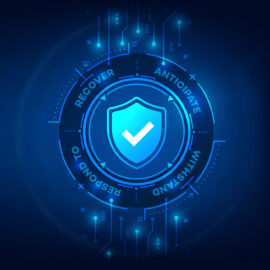Too often we assume adverse events like bad weather or natural disasters won’t affect us. We think others are in danger, not us.
It happens with cybersecurity, too. Those other organizations will be attacked with ransomware, not mine.
But the “ostrich approach” to cybersecurity – where you stick your head in the sand and hope for the best – doesn’t work. Recent statistics show that cyberattacks can happen to everyone – and they can happen often, even repeatedly to the same victims. In fact, an industry study indicated the likelihood of experiencing a data breach in the next two years was nearly 52%.i Expand that out over time and it means organizations of all sizes have the potential to be attacked. So, given the frequency of attacks, it’s not really a matter of if, but when.
Even more alarming, you may not even know you’ve been hit. On average it takes 212 days to identify a data breach and an additional 75 days to contain it.ii That means if your organization was attacked on Jan. 1, the breach would be detected on July 31 and contained on Oct. 14. Can you afford to give cyber attackers unrestricted access to your systems and data for seven months? Plus, the longer it takes to detect and contain the breach, the more expensive the remediation, with an average increase of 30% in costs for incidents that last longer than 200 days.iii
Cybersecurity Protections
A critical step in building your organization’s cybersecurity plan is safeguarding what matters most. In other words, ensuring you’ve got protections in place. Just how important is this step? Having these sorts of robust security measures reflects a strong cybersecurity position. That means your organization can detect an incident, respond to it, and recover – ideally in less time than the 287 days it takes on average now.
When you partner with Rehmann Technology Solutions, your organization’s protections are run through a gap assessment against the National Institute of Standards and Technology (NIST) Cybersecurity Framework, a set of more than 100 security control recommendations across five common IT functions that can be customized for your specific risks and environment. The NIST structure helps to systematically reduce cybersecurity risk through policy, operations, and technology.
The practices in the NIST framework are known to be effective against cyberattacks. Recommended controls include taking stock of organizational devices and applications, limiting access to technology assets to only those who need them, monitoring network activity, and more.
With Protect, your organization will know its attack readiness, how it stacks up to cybersecurity best practices, and where improvements can be made. For controls that may not be in place yet, we provide an actionable plan that can easily be adopted by your organization. It’s grouped into different projects that can bridge the gaps as time, budget, and personnel allow, providing you with flexibility.
Protect Yourself Today
The statistics clearly indicate every organization needs protection from cyberattacks. Don’t make the mistake of thinking it won’t happen to you – don’t be an ostrich with your head in the sand.
Cyberattacks and natural disasters do not behave similarly. Avoiding the latter doesn’t mean you’ll avoid the former. Keep in mind, the real-world data shows it’s not a matter of if, but when.
When you strengthen your cybersecurity defenses, you protect your entire organization.
i IBM and Ponemon Institute, 2019, “Cost of a Data Breach Report”
ii IBM and Ponemon Institute, 2021, “Cost of a Data Breach Report”
iii IBM and Ponemon Institute, 2021, “Cost of a Data Breach Report”





